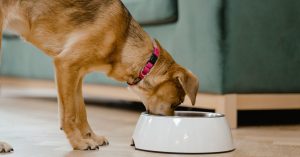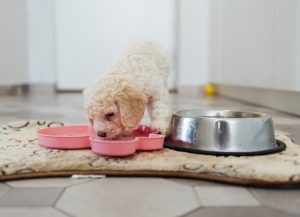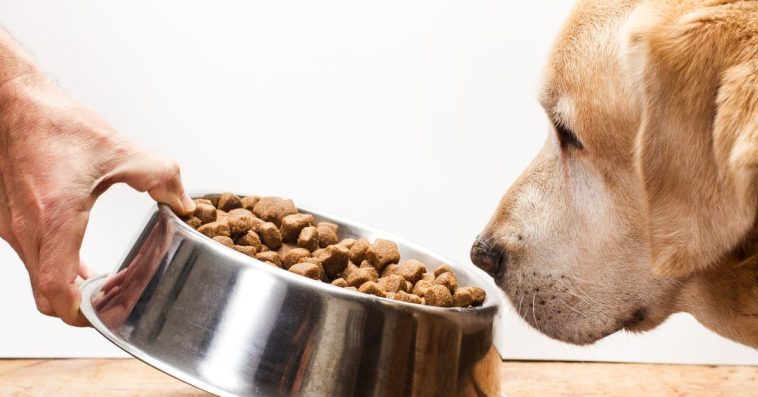Tired of searching “what is the best food to give my dog” or “what are the healthy dog food options”? Then worry no more. You are at the right place.
Your cute little furry friend deserves the healthiest start possible. Here are 8 tips on how to choose the healthiest dog food to suit your puppy’s unique nutritional requirements.
Know these things before you buy dog food online.
8 Tips For Selecting The Healthiest Dog Food

Photo Credits – Respective Owner
1. Give Puppy Food To Puppies
This tip is basic yet very important.
Separate puppy and dog food brands aren’t just a marketing gimmick.
Puppies who are still developing shouldn’t consume adult dog food because it is processed differently from food for puppies.
Puppies require special food that is easy to swallow and digest and contains all the nutrients they need to grow. This includes everything from the size of the kibble to the nutritional profile.
2. Consider Dry Food
Puppies will eat both dry and moist food. The recommended feeding schedule for pups is four times daily instead of the two meals per day recommended for older dogs. The reason for this is that puppies develop twenty times more quickly than dogs do.
As a result, you’ll need to give your puppy lots of chances to eat.
This is not to say that pups consume more than typical dogs. Instead, they require significantly less food. Depending on your puppy’s weight and age, as indicated in the chart below, you will need to progressively increase the number of grams you feed them.

It is simpler to monitor portions and keep food for dogs fresh throughout the day when you feed your puppy kibble or dry food. Also, as dry dog food is never diluted with water, it has a substantially higher protein content.
3. Food And Routine Are Equally Important
Your dog’s food ingredients are important.
The connection between food and your dog is both emotional and physical, though.
If your dog’s emotional relationship with food is damaged, it doesn’t matter if you have best pet food on hand—it still might acquire unhealthy eating habits.
Puppy feeding should follow a rigorous schedule with precise meal times. They help create regularity and improve the mentality toward eating and digestion. After lunch starts and your puppy has not shown any interest in eating for fifteen minutes, you should remove the food to prevent grazing.
Never interrupt your dog when they are eating so that they can enjoy their food undistracted. It might cause aggressive behavior or separation from food if you take away the bowl or disturb them while they are eating.
4. Choose One Food And Stick With It.
You’ll want to stick with the same food source to make this job easier because giving your puppy the right amount of food will be your main concern.
Dogs don’t need a three-course menu or different meals as people do.
If dogs get a consistent meal with the proper ratio of protein and fat, as well as one that is rich in nutrients, it will be simpler for them to establish a solid relationship with food.
Increasing the weight of food will be challenging if you choose a meal type and then decide to switch to a different one because the nutritional value of each item will differ.
The goal of gradually increasing the food in relation to your dog’s weight is to gradually increase the meal’s consumption and all of its nutritional advantages. As not all foods are created equal, transferring the same amount of food from one brand to another could be likened to consuming a handful of chocolate or raspberries.
5. Stick To Dog Food
Dogs may be a man’s best friend, but their company ends at the dinner table.
While it may be tempting to develop a bond with your dog over food, feeding them leftovers from your plate promotes unhealthy habits, poor health, and misbehavior.
Certain foods safe for human consumption but toxic to dogs may go unnoticed by inexperienced dog owners. The food that we should eat more of but never give to our puppies is grapes, which is a fantastic example.
In conclusion, however how tempting it may seem, never feed dogs human food.
Once you start giving your food to dogs, it can be challenging to stop both the behavior and the expectations your dog has developed as a result.
6. Choose Only Natural Ingredients
Natural food is usually the best dog food for puppies.
Since you can’t change your puppy’s food, you should build a strong foundation with no artificial additives or hidden fillers.
Even as young puppies, dogs take longer to digest food. This means that dogs can’t tolerate chemical meal combinations because they will easily upset their stomachs and result in a variety of digestive issues.
As long as you avoid being misled by marketing, identifying all-natural food is simple.
If you have to block out words like “natural,” do your best to ignore any strong claims on the front label. Instead, you should pay close attention to the list of components to determine whether the mixture contains only healthy elements.
The kibble is likely all-natural if you can identify every ingredient on the list.
7. Choose Low-Fat Treats.
The excitement of getting a new puppy may lead you to want to purchase every item on the market.
The majority of your training will take place during these early phases of growth. Thus training treats should be minimal in fat, especially for pups. It’s simple to mistakenly overfeed dogs treats and raise their weight above the advised limit. To help with weight increase, puppy food contains more fat per serving than standard dog food. This indicates that puppies don’t require extra fat for the duration of the day.
You should use the same methods for training with food as you would with ordinary kibble and refrain from changing the kinds of treats you give your dog. Even though it may seem boring to you, consistency is beneficial for your dog’s digestive system and the advancement of his or her obedience training.
8. Go Hypoallergenic If In Doubt
As allergies can develop over time, you won’t yet be able to tell if your dog has any.
Nonetheless, it’s always better to be safe than sorry, so if you see hypoallergenic food on the shelves, always choose it.
If a dog doesn’t have allergies, eating hypoallergenic food won’t hurt them, but it will protect them. This makes it unnecessary for you to refrain from feeding your dog hypoallergenic food that lowers the likelihood of an allergic reaction.
Try These Puppy Food

The following diets for puppies are some of the best to discuss with your veterinarian:
Try These Wet Puppy Food
- AvoDerm Natural Wet Puppy Food
- Merrick Grain-Free Puppy Plate Chicken
- Wellness Complete Health Just for Puppy
Try These Dry Puppy Food
- Blue Buffalo Life Protection Puppy Chicken and Brown Rice
- Iams Proactive Health Smart Puppy
- Nature’s Logic Grain-free Canine Duck & Salmon Meal Feast
- Orijen Dry Puppy Food
- Wellness Complete Health Dry Puppy Food
When To Transition Your Dog To Adult Food
When switching puppies to adult dog food, it’s not necessary for them to be completely grown, but you should wait until their growth curve has greatly flattened. The schedule is as follows:
- 7-8 months for small breeds
- 8–10 months for large breeds
- Breeds of giants: 10–12 months
These figures are not set in stone. They serve as a foundation for personalized nutrition planning.
Debunking A Common Misconception About Puppy Food
You may have read or heard that eating too much protein might lead to development problems in dogs. This is a myth.
Growth problems can be worsened by overfeeding or by giving too many minerals (which can be found in meat but not protein, which may be where the misconception arises).
As a supplement, minerals are frequently added to food and are not just found in meat. Protein is unrelated to this at all.
We hope you learned something new related to dog foods by reading this article. What foods do you give your dog? Please let us know in the comments, and don’t forget to spread the news so that we can hear from more people.


